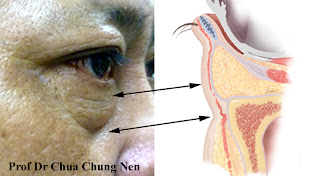In some patients, the age-related
changes include a deepening of the fold running along the orbital rim. This is
known as the nasojugal fold or commonly called the tear trough (from the
observation that tears will track along this groove). This structure creates a
tired look. In addition, the shadow produced by this structure gives the
appearance of dark circle.
Nasojugal folds or tear troughs (arrowed).
Anatomically, the tear trough
corresponds to the attachment between the orbicularis muscle (the muscle that
closes the eyes) and the underlying orbital rim and the midface.
Side view of tear trough and the corresponding structure.
Front view of tear trough and the corresponding structure.
Surgically, the tear trough is
difficult to treat using the traditional method of lower blepharoplasty in
which only fat is removed. Furthermore, excessive fat removal can make the tear
trough more prominent.
Patient without prominent tear trough, traditional
lower blepharoplasty gives good aesthetic result.
Patient with obvious tear trough, traditional lower blepharoplasty
does not remove the lines which resemble dark circle.




